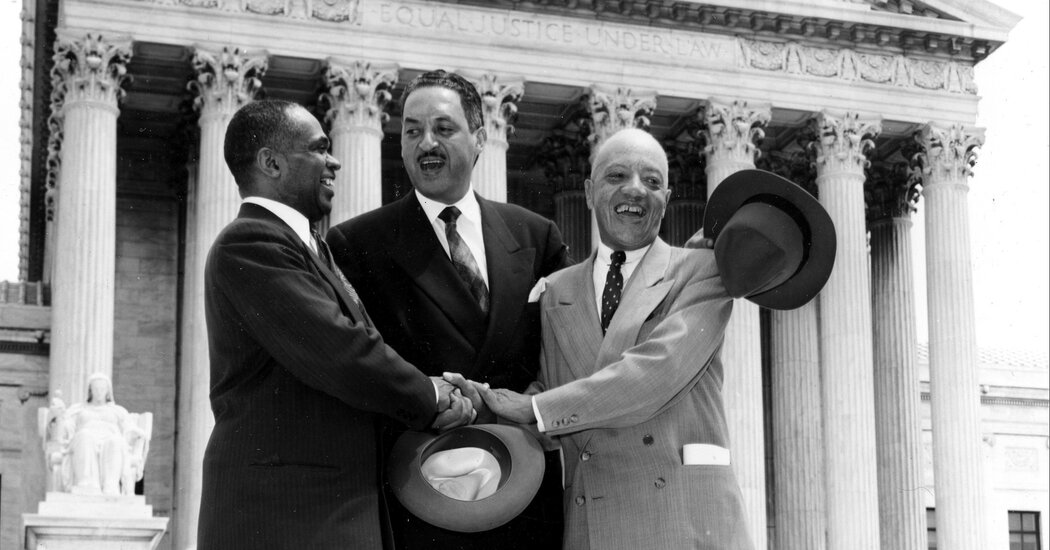
WASHINGTON — In the Supreme Court decision that eliminated the constitutional right to abortion, the justices engaged in an extended debate over the meaning and legacy of Brown v. Board of Education, the 1954 decision that said the Constitution does not permit racial segregation in public schools.
The connection between abortion and education may seem elusive. But the justices cited Brown 23 times, using it to make points about precedent, about popular opinion and, most tellingly, about how to interpret the Constitution.
Justice Samuel A. Alito Jr., writing for the five-member majority, invoked Brown as an example of a decision that had properly overruled a precedent. Plessy v. Ferguson, the 1896 decision that said “separate but equal” facilities were constitutional, was plainly and egregiously wrong, he wrote, and so Brown had been right to overturn it.
The same was true, Justice Alito wrote, of Roe v. Wade, the 1973 decision that had guaranteed a constitutional right to abortion, and Planned Parenthood v. Casey, the 1992 decision that had reaffirmed Roe’s core holding.
Chief Justice John G. Roberts Jr., in a concurring opinion that would have stopped short of overruling Roe, failed to see the parallel. “The opinion in Brown,” he wrote, “was unanimous and 11 pages long; this one is neither.”
Indeed, the three dissenting justices wrote in a joint opinion, “a bare majority” of the current court had overruled the two abortion precedents.
“The majority has overruled Roe and Casey for one and only one reason: because it has always despised them, and now it has the votes to discard them,” Justices Stephen G. Breyer, Sonia Sotomayor and Elena Kagan wrote.
Justice Alito also cited Brown, which was deeply unpopular in the South, in support of a second point. “We cannot allow our decisions to be affected,” he wrote, “by any extraneous influences such as concern about the public’s reaction to our work.”
But the most intriguing mention of Brown was made almost in passing in the dissent. It said the court that had decided Brown might not have done so had it used “the majority’s method of constitutional construction.”
That method was originalism, which seeks to identify the original meaning of constitutional provisions using the tools of historians.
Read More on Abortion Issues in America
But Brown has always been problematic for originalists. The weight of the historical evidence is that the people who from 1866 to 1868 proposed and ratified the 14th Amendment, which guaranteed “equal protection of the laws,” did not understand themselves to be doing away with segregated schools.
Yet Brown is generally considered to be a moral triumph and the Supreme Court’s finest hour. A theory of constitutional interpretation that cannot explain Brown is suspect, if not discredited.
Originalists hate talking about Brown. When Justice Antonin Scalia, an enthusiastic originalist, used to be asked about the case, he was prone to say, “Waving the bloody shirt of Brown again, eh?”
Justice Alito’s critique of Roe was certainly steeped in originalism. In ruling that there is no constitutional right to abortion, he focused on the words of the Constitution and “how the states regulated abortion when the 14th Amendment was adopted.”
His approach echoed contemporary criticism of Brown on originalist grounds.
Justice Alito said that “the Constitution makes no mention of abortion.” A 1956 statement by Southern members of Congress who objected to Brown, which came to be known as the Southern Manifesto, made a similar point: “The original Constitution does not mention education. Neither does the 14th Amendment nor any other amendment.”
In the abortion decision, Justice Alito wrote that “by the time of the adoption of the 14th Amendment, three-quarters of the states had made abortion a crime at any stage of pregnancy, and the remaining states would soon follow.”
The Southern Manifesto again echoed the point.
“When the amendment was adopted, in 1868, there were 37 states of the union,” the manifesto said. “Every one of the 26 states that had any substantial racial differences among its people either approved the operation of segregated schools already in existence or subsequently established such schools by action of the same lawmaking body which considered the 14th Amendment.”
The unanimous opinion in Brown did not really quarrel with the idea that it could not be justified using the tools of originalism. “At best,” the opinion said, the historical evidence was “inconclusive.”
Before Justice Scalia died in 2016, he and Justice Breyer, who retired in June, would occasionally appear in public to debate constitutional interpretation. Justice Breyer liked to needle Justice Scalia about Brown.
“Where would you be with school desegregation?” Justice Breyer asked his colleague in 2009, at an appearance at the University of Arizona. “It’s certainly clear that at the time they passed the 14th Amendment, which says people should be treated equally, there was school segregation, and they didn’t think they were ending it.”
Justice Scalia did not give a direct answer. In other settings, he endorsed the decision. “Though Scalia says that he would have voted with the majority in Brown,” Margaret Talbot of The New Yorker wrote in a 2005 profile, “it’s hard to see an originalist justification for it.”
The majority in the recent abortion decision, Dobbs v. Jackson Women’s Health Organization, noted that both Plessy and Roe had survived about a half-century before being overturned.
The three dissenters responded that Plessy might still be on the books if the court in Brown had been committed to originalism.
“If the Brown court had used the majority’s method of constitutional construction,” the dissenters wrote, “it might not ever have overruled Plessy, whether five or 50 or 500 years later.”




